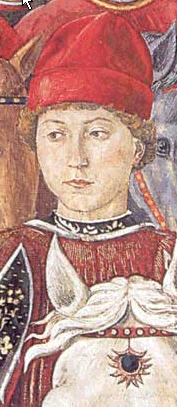1459 [4 June – extract from Ortalli 1996b]
"Further proof of the Este interest in mechanical card production comes […] from a note of 4 June 1459 concerning objects lent to a certain Anselino di Salimbeni by the prince; among them was a box containing "stampe for trump cards"[see note 90]. I would say that those stampe were printing blocks and the fact that Duke Borso actually owned them is highly significant. They may well have been the blocks for a whole pack bought in January 1454, recorded in the book Conti di Borso: "uno paro de forme de carte, the printing blocks for a pack of cards purchased from Piero Andrea da le Fenestre" for 20 ducats [see note 91]."(Note 90): ASMO, Guardaroba, 7, Ricordo, 1442-1465, fol. 34. I am again indebted to Adriano Franceschini for this information. (Note 91): Franceschini 1993, p. 415, n. 731a.
Ortalli relates these informations to another entry in 1494:
"The end of this phase would seem to be refleced in the Este Guardarobe inventory of 1494. In the list of boxes, safes, caskets, wooden works and cupboards, we find an entry for 'a small box containing printing blocks for playing cards'. I would surmise that these were the same blocks purchased by Borso in 1454, by now classed with old things that had seen better days. For its requirements the court no longer resorted to painters, but neither did it keep a close check on the work of printers. Tellingly, the box containing woodcuts was classed in the inventory along with old white and coloured ostrich feathers which were 'dyed with several colours, moth eaten and broken'. But there was perhaps an even more significant object alongside the moth-eaten ostrich feathers and old woodcut - 'a box with various kinds of old playing cards in a bad state'. In short, a box containing a hotchpotch of old worn cards no one could bring themselves to throw out: 'Una capseta cum carte da zugare de piu rasone vechie et male conditionate'. (Campori 1870, pp. 33-34)"
[Ortalli 1996b:194]
The year 1459 is dominated by the Congress of Mantua, which did lead to much direct communication between the leading families of Italy. The 15-years-old Galeazzo Maria visited Florence during the stay of Pope Pius II (April/May), who was at his journey to Mantova, and was honoured with careful respect as the representative of Milan. There are a lot of festivities in that time and one of them is shown at the famous paintings in the Palazzo Medici-Riccardi, Florence, by Benozzo Gozzoli, 1459-61. Most art historians believe this is the 15-year old Galeazzo Maria. Lorenzo de Medici is in this year 10 years old.
Beside the Congress of Mantua in Florence the Platonic Academy is refounded by Marsilio Ficino, a regularely meeting of intellectuals, poets, artists and philosophers, under them also people of much political influence (1463 established at the villa Careggi). This talking group became the heart of art revolution in Florence.
